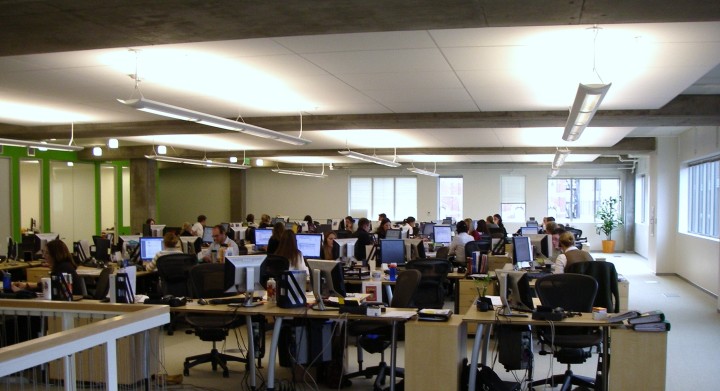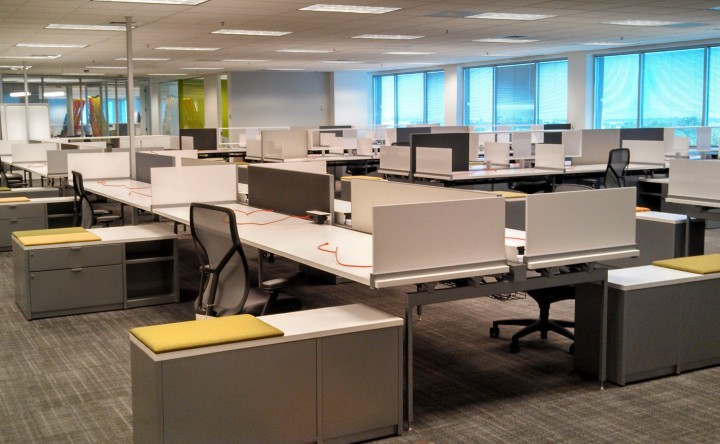Bad acoustics are the culprit in many unsuccessful workplace design projects. Below, Steve Johnson, a principal at ADI Workplace Acoustics, explains how and why the proper use of sound absorbing materials and sound masking can make all the difference.

What an exciting time to be involved in the design and construction of the workplace. Amazing changes are taking place: technology is allowing for more mobility, and mobility is changing many concepts of assigned space. The result, in many diverse ways, is a more open workplace with less personal space. It seems every week there is major publication that is showing off a new workplace full of bright light, low or no panels, few assigned spaces, and loads of amenities.
In the articles, the advocates talk about collaboration and serendipitous interaction. But the comment sections are full of messages from employees in similar space that are screaming, “I don’t like it here,” “I can’t concentrate,” and “It’s too loud.”
A short walk through NeoCon this year confirms that the industry understands that there is a problem. There was a huge emphasis on quiet spaces from beautiful demountable walls that provide heads down quiet concentration space to fuzzy wrap-around furniture to provide a simulated “cone of silence.” As a person who focuses on workplace acoustics, it was all very interesting.
Many spaces that do not succeed have one common problem: bad acoustics. The Wall Street Journal recently cited a study which found that once distracted, it can take 23 minutes for the average worker to regain concentration on a task.
There are many new spaces out there that work well for their occupants and successfully meet business goals for their owners. However, many of the spaces that do not succeed have one common problem: bad acoustics. The most common symptom of bad acoustics is frequent or constant distraction from conversations. When employees are distracted, they are less productive, make more errors and are less satisfied in their work. The Wall Street Journal recently cited a study which found that once distracted, it can take 23 minutes for the average worker to regain concentration on a task.
Two key tools are available to help with the acoustical challenges in open work environments: sound absorbing materials and sound masking.

Sound Absorbing Materials
Absorptive materials reduce the amount of sound that ricochet’s off of one hard surface to another. Picture a space with an exposed concrete structure above, windows around the perimeter and a polished concrete floor. The sound of speech bounces around from one hard surface to the next. It has nowhere to go but into the ears of the employees. As one employee talks on the phone, a nearby employee talks a little louder to be heard. This competition continues until the space sounds like a call center and focus is impossible.
Using a high performing acoustical ceiling tile with a Noise Reduction Coefficient (NRC) rating of 75 or higher will absorb a significant amount of sound in the space. The NRC rating measures the percentage of sound energy that is absorbed by a material and kept from bouncing back into the space. (A word of caution: high NRC ceiling tiles should not be used in areas with loud HVAC components or over offices and conference rooms. In these areas, mineral board tiles are required to act as a lid to contain sound.)
If ceilings do not fit into the design concept, absorptive materials should be found in more creative ways. Ceiling mounted baffles and wall mounted acoustical panels are available in many interesting varieties. The improvement will be felt in lower voice levels for employees. Sound will not build up as strongly with the reduced reflection.
Sound Masking
The job is not yet done! Most commercial office buildings have a relatively low level of background sound. This low ambient noise level is due to efficient HVAC systems and good exterior insulation. Low ambient background sound is the enemy of concentration. When a space is very quiet, a whisper can be understood at great distance. This is one of the key factors in employee productivity. If every nearby conversation can be overheard and understood then focus becomes a difficult challenge.
In a wide open environment, a well-tuned sound masking system will reduce the distance at which conversations can be understood.
Sound masking is a soft, uniform background sound. By slightly elevating the ambient noise level, conversations at a distance becomes unintelligible. Most people describe it as similar to soft rushing air. A sound masking system is comprised of a network of speakers which are located above the ceiling, suspended from an exposed structure or under raised access flooring. When commissioned properly, occupants of the space are unable to determine the source of the sound.
In a wide open environment, a well-tuned sound masking system will reduce the distance at which conversations can be understood. This is measured as the Radius of Distraction. In most offices, the radius of distraction is approximately 30 to 60 feet. Within that radius, employees are distracted by all of the nearby conversations. With the addition of sound masking, that radius is reduced to 10 to 15 feet.
This improvement allows employees to collaborate freely, yet their collaboration does not distract the population who surrounds them.
Workplace trends may swing over time but it seems that the open office is here for the foreseeable future. Design teams that include acoustics in their planning check list will find end-users more productive and more satisfied once the space is complete.



The basic technical info and specs you have provided are very valuable. Thanks for sharing.
Excellent content that is relevant as commercial offices convert to the open plan concept. Every interior designer and facilities manager would benefit from this article.
[…] When Bad Acoustics Happen to Good Workplaces What an exciting time to be involved in the design and construction of the workplace. Amazing changes are taking place: technology is allowing for more mobility, and mobility is changing many concepts of assigned space. The result, in many diverse ways, is a more open workplace with less personal space. It seems every week there is major publication that is showing off a new workplace full of bright light, low or no panels, few assigned spaces, and loads of amenities… WorkDesign Magazine […]
We’ve also put in place some of these sound adsorbing and masking and found they really do help, at the end of the day no two people will work in the same way. There are some more statistics regarding noise dampening that we found, here… http://paramountinteriors.com/shh-office-furnishing/
Our company has helped 100’s of offices like this solve their acoustic problems. We are happy to help you with any questions, feel free to reach out to us at http://MixmasteredAcoustics.com
Praxis Workplace Graphics products offer a range of options with sound absortion properties. Praxis Mono and Kube screens provide a flexible way to enhance the workplace interior and reduce noise. Visit the website for more information.
Kyalami Park, Midrand, South Africa produce a quarterly magazine – you can view on their website or on http://www.kyalami-park.co.za.
We would love to use one or two or your articles . . . would you have any objections as long as we acknowledge source?
Sometimes you find the acoustic element is not considered to be the priority during CAT A fit-outs. If clients have problems in the space on occupation a good aftermarket solution might be to add lighting with acoustic control properties, we have helped clients on a number of projects after the building has been handed over. We have designed and supplied solutions for complete office or just small breakout spaces, http://www.299lighting.co.uk/news/acoustic-lighting
Great work! Does anyone know or have an access to WSJ study about the concentration?
I am taking about this part:
Many spaces that do not succeed have one common problem: bad acoustics. The Wall Street Journal recently cited a study which found that once distracted, it can take 23 minutes for the average worker to regain concentration on a task.
I will be really grateful for any help.
[…] Read more on workdesign.com/2014/08/avoid-…. […]